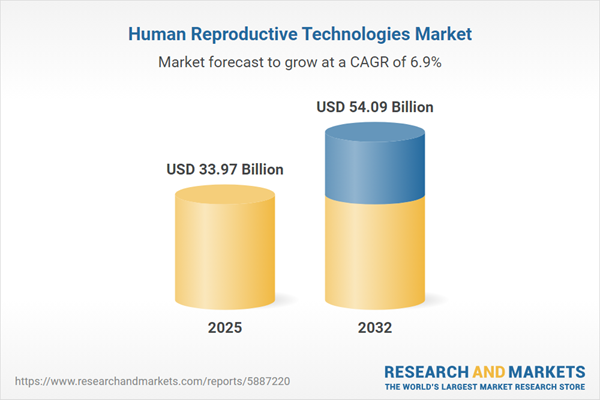Speak directly to the analyst to clarify any post sales queries you may have.
The human reproductive technologies market is undergoing rapid transformation as digital innovations, changing regulations, and evolving patient expectations reshape clinical practices and operational priorities. Senior decision-makers face increasing pressure to align organizational agility with advances in patient care models, leveraging new technologies to navigate shifting market dynamics.
Market Snapshot: Human Reproductive Technologies Market
The human reproductive technologies market is experiencing robust expansion, underpinned by continuous innovation in clinical outcomes and service delivery models. Currently valued at USD 31.82 billion and projected to reach USD 54.09 billion by 2032, the market’s compound annual growth rate of 6.85% signals strong, ongoing momentum. Organizations are prioritizing investments in digital platforms and advanced laboratory systems to streamline operations, strengthen patient engagement, and scale care delivery effectively. As regional factors—such as distinct regulatory environments, demographic variations, and operational requirements—continue to evolve, industry stakeholders are focused on adaptive strategies and responsive partner selection to maintain agility and meet diverse patient and business needs.
Scope & Segmentation: Actionable Insights for Senior Leaders
This comprehensive report delivers executive-level guidance through detailed segmentation and strategic insight, enabling organizations to develop competitive approaches and build alignment with current industry dynamics. The following segments are critical to shaping operational strategy and investment decisions in the human reproductive technologies market:
- Assisted Reproductive Technology Types: Examine clinical solutions such as gamete intrafallopian transfer, zygote transfer, multiple IVF modalities, intracytoplasmic sperm injection, and intrauterine insemination, contributing to tailored care pathways.
- Application Areas: Consider embryo, oocyte, and sperm cryopreservation alongside advanced genetic diagnostics, supporting improved fertility preservation and innovative clinical protocols.
- Fertility Drug Types: Review treatment options centered on GnRH analogues, gonadotropins, hCG, and progesterone, enabling therapy optimization across diverse patient groups.
- Service Providers: Analyze the roles of fertility clinics, hospitals, and research organizations as they expand laboratory standards and drive benchmarks in quality care.
- End Users: Evaluate inclusive care models for heterosexual couples, LGBTQ couples, and single parents, advancing market differentiation and accessibility.
- Regional Coverage: Assess distinctions within the Americas, Europe, Middle East & Africa, and Asia-Pacific, focusing on regulatory requirements, demographic characteristics, and investment patterns to inform local strategies.
- Key Company Profiles: Examine the impact of key firms, including Merck KGaA, Ferring Pharmaceuticals A/S, Progyny, Vitrolife AB, Cook Medical, CooperSurgical, Natera, Illumina, Laboratory Corporation of America Holdings, and Thermo Fisher Scientific, on technology development and quality advancement.
Key Takeaways for Strategic Decision-Makers
- Genetic screening and diagnostics are enabling more personalized, patient-focused treatment approaches and contributing to advanced clinical workflows adapted to emerging demands.
- Telemedicine solutions and remote patient monitoring are extending the reach of clinical services, supporting timely decision-making, and reinforcing patient engagement beyond traditional settings.
- Consistent, transparent communication throughout care cycles builds trust between providers and patients, facilitating participation and successful reproductive treatment experiences.
- Strategic partnerships among corporate, research, and clinical entities are accelerating therapy development, driving sector-wide improvements, and fostering the exchange of best practices.
- Agile resource management and integrated service models strengthen the ability of organizations to respond swiftly to regulatory changes, new technologies, and evolving patient needs.
- Sound business planning and financial oversight are essential to maintaining operational stability, particularly as supply chain conditions and regulatory frameworks continue to evolve.
Tariff Impact: Navigating U.S. 2025 Policies in Reproductive Technology
Forthcoming changes to U.S. tariff regulations on imported reproductive technologies are reshaping procurement strategies and supply chain processes. Domestic suppliers are expanding engagement with regulatory agencies to ensure supply consistency and cost management. Healthcare organizations are also updating pricing and reimbursement frameworks to address these policy shifts, supporting stable access to reproductive care domestically and globally.
Methodology & Data Sources
This analysis draws on primary interviews with clinicians, laboratory experts, and policy professionals, complemented by secondary research and validated data sources. The combined approach produces reliable segmentation and informed executive decision support.
Why This Report Matters
- Delivers actionable insights aligning strategies with ongoing regulatory, technology, and clinical practice changes throughout the human reproductive technologies sector.
- Equips leadership with region-specific intelligence for risk management and opportunity identification in an evolving regulatory and demographic environment.
- Provides practical frameworks for devising operational responses to market and regulatory change.
Conclusion
Ongoing investments in technology and operational adaptation drive resilience and relevance for organizations in human reproductive healthcare. Strategic planning supports sustainable positioning as the sector continues to evolve.
Additional Product Information:
- Purchase of this report includes 1 year online access with quarterly updates.
- This report can be updated on request. Please contact our Customer Experience team using the Ask a Question widget on our website.
Table of Contents
3. Executive Summary
4. Market Overview
7. Cumulative Impact of Artificial Intelligence 2025
Companies Mentioned
The companies profiled in this Human Reproductive Technologies market report include:- Merck KGaA
- Ferring Pharmaceuticals A/S
- Progyny, Inc.
- Vitrolife AB
- Cook Medical LLC
- CooperSurgical, Inc.
- Natera, Inc.
- Illumina, Inc.
- Laboratory Corporation of America Holdings
- Thermo Fisher Scientific Inc.
Table Information
| Report Attribute | Details |
|---|---|
| No. of Pages | 180 |
| Published | October 2025 |
| Forecast Period | 2025 - 2032 |
| Estimated Market Value ( USD | $ 33.97 Billion |
| Forecasted Market Value ( USD | $ 54.09 Billion |
| Compound Annual Growth Rate | 6.8% |
| Regions Covered | Global |
| No. of Companies Mentioned | 11 |









